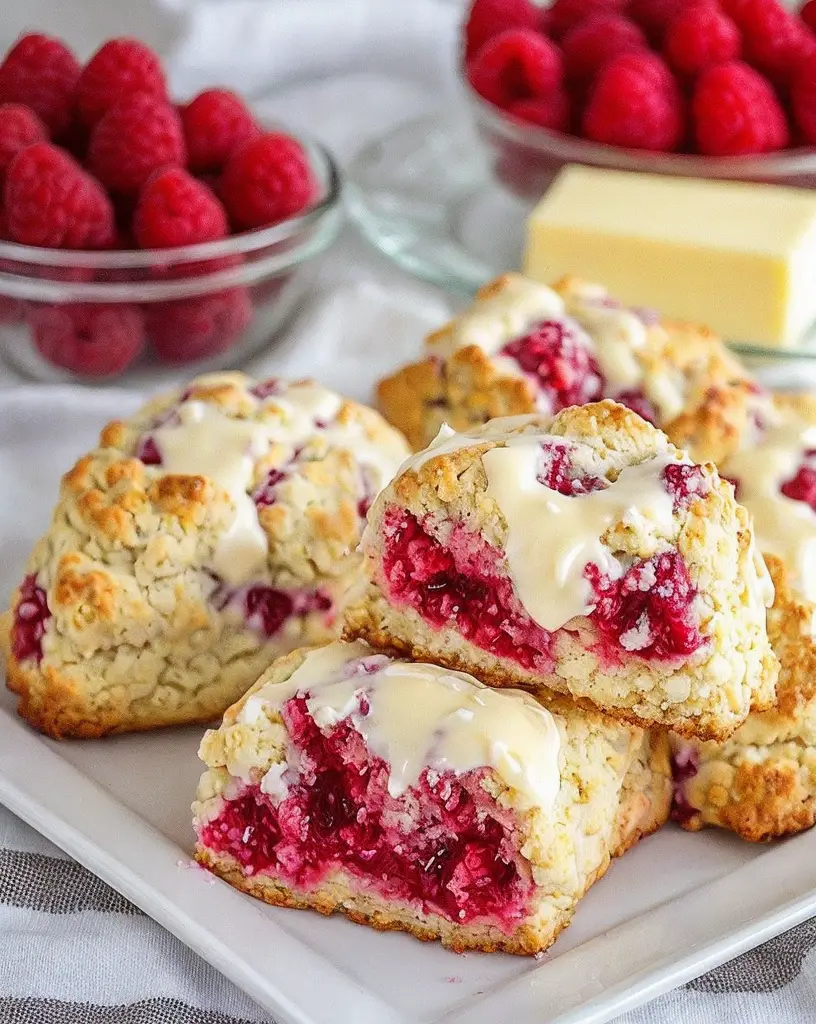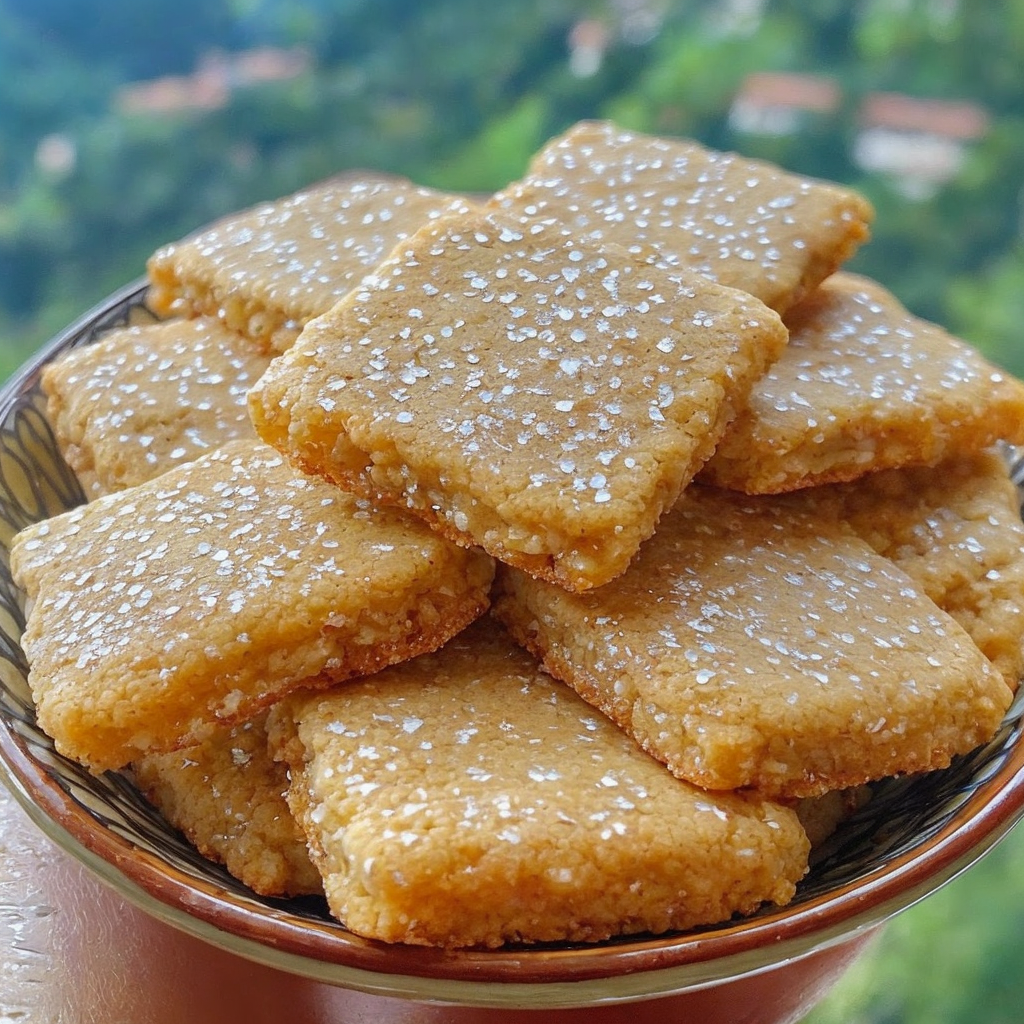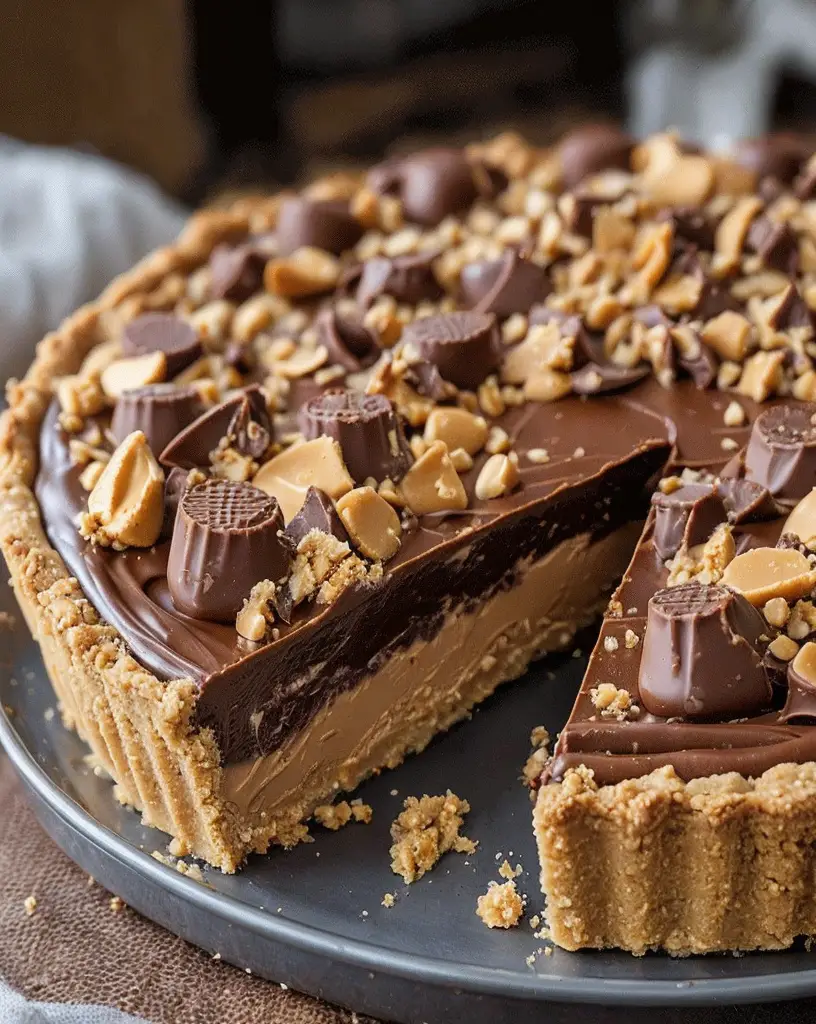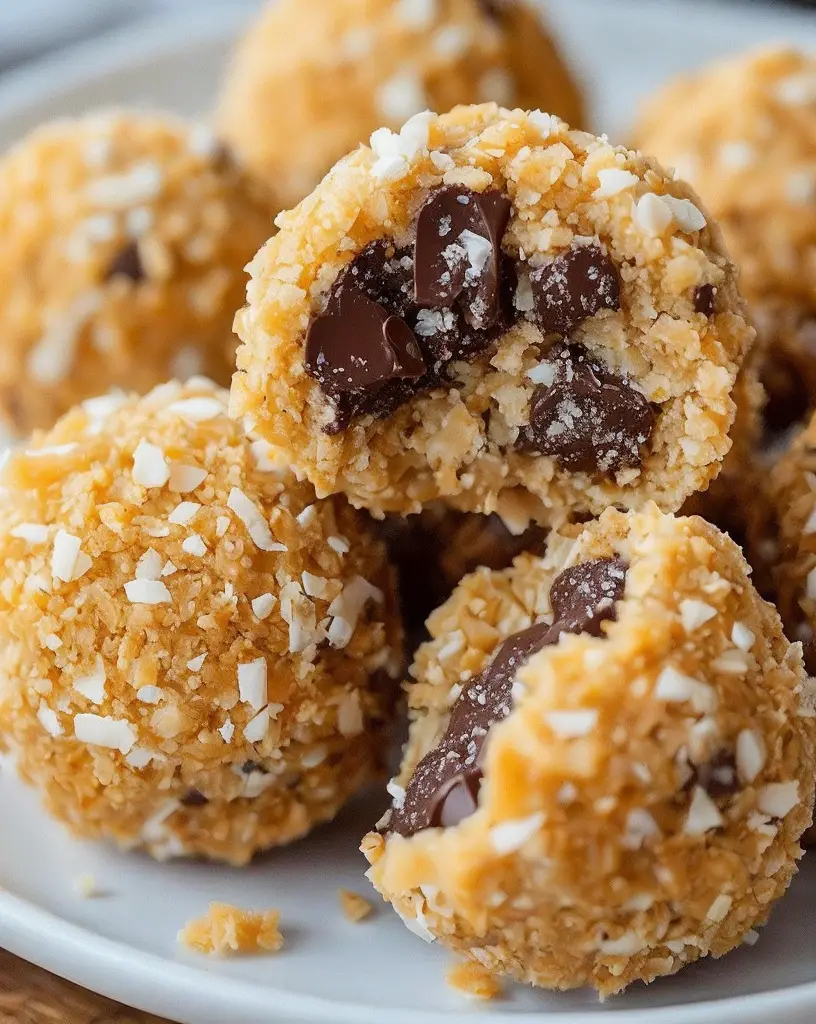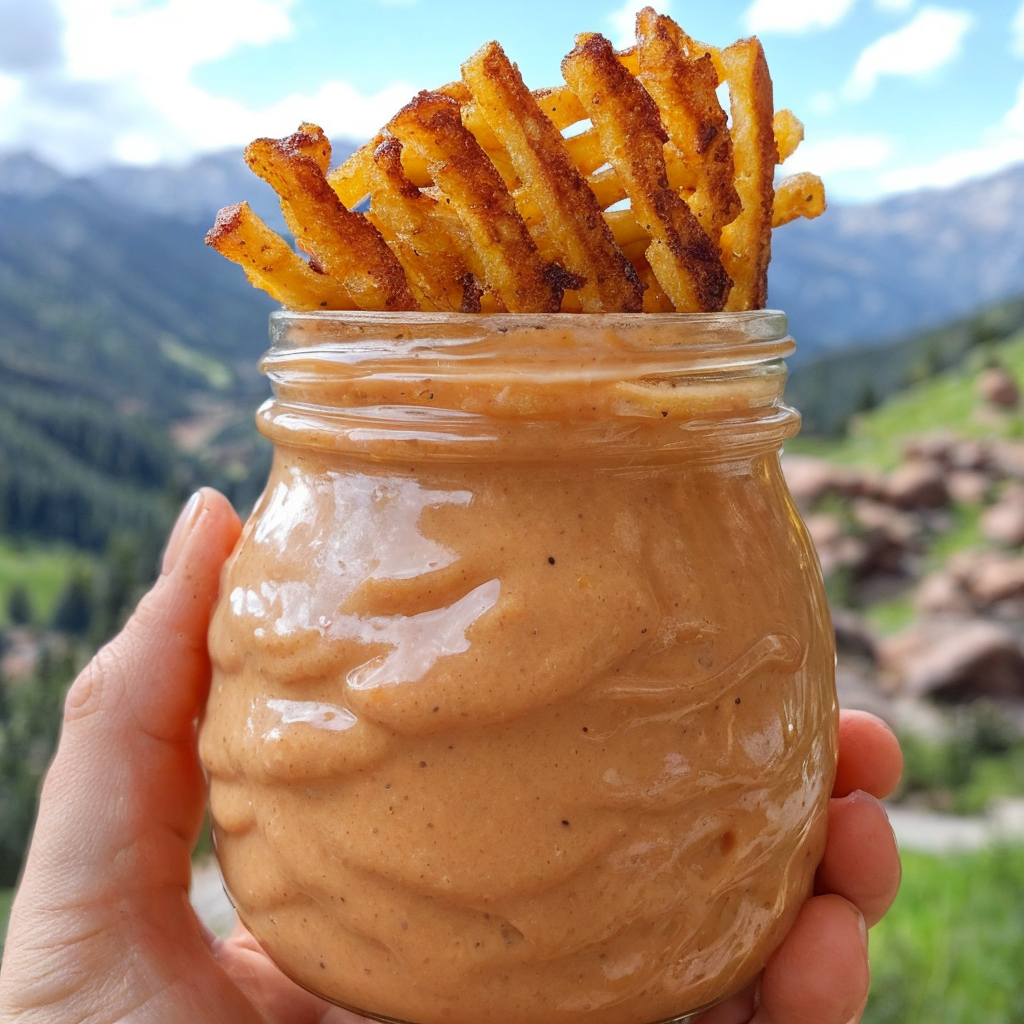Best Raspberry White Chocolate Scones Recipe: A Sweet Delight
These raspberry white chocolate scones are a delightful treat that combines the tartness of raspberries with the creamy sweetness of white chocolate. Perfect for a brunch spread or a cozy afternoon snack, this easy scone recipe will surely impress. With every bite, the tender crumb, dotted with raspberry pieces and pockets of melted white chocolate, delivers a burst of flavor that is both rich and refreshing. If you’re looking for a bake that will yield luxurious aromas while also being straightforward enough for any level of baker, this scone recipe is for you.
Quick Recipe Highlights
- Flavor Profile: Tart raspberries beautifully contrast the sweetness of creamy white chocolate in this scone recipe. The balance ensures that each bite is bursting with complex flavors, making it more than just a sweet treat.
- Texture: The scones are wonderfully flaky and offer a tender crumb that melts in your mouth. The combination of juicy raspberries and chunks of white chocolate adds irregular pockets of texture that make each bite interesting.
- Aroma: These scones emit a sweet, buttery aroma as they bake, with hints of vanilla and chocolate, inviting you to indulge in their delightful scent.
- Visual Appeal: Speckled with bright red raspberries and creamy white chocolate, these scones are as beautiful as they are delicious. Their golden-brown tops and soft centers create a visually appealing contrast.
- Skill Level Needed: Suitable for both novice and experienced bakers, this recipe requires basic baking skills and mostly involves mixing ingredients and shaping the dough.
- Special Equipment: A baking sheet and parchment paper are all that’s needed to achieve perfectly baked scones. No special equipment necessary!
Recipe Overview
- Difficulty Level: With straightforward steps and simple mixing techniques, this recipe is labeled as easy, even for those new to baking. The most challenging part may be achieving the right dough consistency, but with detailed instructions, you’ll find it manageable.
- Category: Perfect as a breakfast or brunch option, these scones double as a delightful dessert or snack, fitting into any time of day seamlessly.
- Cuisine: While scones feature prominently in British cuisine, this variant utilizes ingredients beloved across cultures, showcasing a more contemporary, fusion approach.
- Cost: With affordable ingredients like flour, butter, and sugar, this recipe won’t break the bank. Seasonal berries can impact cost but typically remain accessible.
- Season: Best enjoyed fresh year-round, but during summer when raspberries are in season, their flavor enhances the overall experience.
- Occasion: These scones are ideal for tea parties, brunches, or even as a comforting baking project on quiet weekends.
Why You’ll Love This Recipe
The taste and texture of these raspberry white chocolate scones are unparalleled. The sweetness of the chocolate and the tangy berries blend seamlessly with the buttery, flaky scone base, creating an utterly satisfying taste experience. Additionally, the preparation process is convenient and straightforward, allowing you to achieve bakery-quality scones at home without any specialized skills. Being able to easily swap in frozen raspberries means the recipe remains accessible any time of year, offering a delightful taste of summer in every bite.
Nutritionally, these scones deliver tastiness without extreme indulgence. Moderation and quality ingredients ensure that you enjoy a treat that can fit into a balanced diet and one that pairs well with a tall glass of milk or a simple cup of tea. Socially, these scones make for delightful conversation starters, whether presented at a brunch or a casual get-together with friends. They embody a sense of care and craftsmanship that speaks volumes about your hospitality skills.
Cost-effectiveness and accessibility make this recipe an all-around winner. Staples like flour and sugar are common kitchen commodities, and with only a few special add-ins, it becomes a luxurious treat that feels far more expensive and decadent than it actually is. Sharing this accessible baking joy with friends and family can create cherished moments around the dining table.
Historical Background and Cultural Significance
Scones have their origins rooted in Scotland, and over centuries, they have evolved into the quintessential tea-time treat we know today. Traditionally, scones were simple recipes made with oats and griddle-cooked; however, they transitioned to being oven-baked with the advent of ovens, elevating their status to a more refined baked good. Culturally, scones are deeply embedded in the British tradition of afternoon tea, symbolizing hospitality and warmth.
The basic scone recipe has seen countless adaptations and is beloved in many regions beyond the UK, thanks to the British colonial influence. Variations have sprung up worldwide, each introducing local flavors and ingredients. The inclusion of berries, particularly in America, highlights the seasonal produce available and reflects a fusion of culinary traditions. In the case of raspberry white chocolate scones, the modern twist offers a crossover between traditional techniques and contemporary flavors.
Over time, these scones have become a staple in coffee shops and bakeries across the globe, with variations being popularized by culinary shows, blogs, and cookbooks. The adaptability of scones to incorporate a wide variety of ingredients makes them ripe for innovation, much like this raspberry white chocolate version. Each region puts its twist on scones, integrating local ingredients and preferences, thus expanding the diversity within this beloved baked item category.
Ingredient Deep Dive
Raspberries offer not only a burst of tangy flavor but also a wealth of nutritional benefits. They are rich in vitamins, fiber, and antioxidants, making them a healthful addition to the scones. When selecting raspberries, look for bright red, plump fruits that are firm to the touch. Store them in the refrigerator and use soon after purchase to take advantage of their peak freshness. If fresh raspberries are unavailable, frozen ones make an excellent substitute and can be added directly to the dough.
White chocolate brings a creamy, sweet dimension to these scones. It should be of good quality to ensure smooth melting and flavor consistency. When choosing white chocolate, opt for bars over chips for better meltability. Store it in a cool, dry place to maintain its texture and flavor integrity. While some may find white chocolate too sweet, alternatives like dark chocolate can offer rich contrasts when substituting for a less sugary option.
Flour forms the backbone of any scone recipe, and for these scones, all-purpose flour provides the perfect balance of structure and tenderness. Always measure your flour accurately by spooning it into a measuring cup and leveling it off to prevent dense, heavy scones. Store flour in an airtight container, away from moisture, to preserve its quality. For those requiring gluten-free options, numerous blends are available, though slight adjustments in liquid ratios may be necessary.
Common Mistakes to Avoid
- Over-mixing the dough can make your scones tough, rather than tender and flaky. Mix only until ingredients are combined.
- Warm butter in the dough will prevent the scones from rising properly. Use cold butter to ensure a flaky texture.
- Using too much flour when shaping can dry out the dough. Use just enough to prevent sticking.
- Neglecting to line the baking sheet with parchment paper can result in scones that stick, damaging their shape.
- Opening the oven door too often during baking can cause scones to collapse. Resist the urge to peek until nearly done.
- Substituting low-fat ingredients can affect the texture and flavor; stick to full-fat for best results.
- Baking at too low a temperature won’t create the desired flakiness. Ensure the oven is properly preheated to 400°F (200°C).
- Failing to space scones adequately on the baking sheet will lead to them touching and mis-shaping as they expand.
Essential Techniques
When making raspberry white chocolate scones, mastering the technique of cutting in butter is crucial. Doing this ensures that butter is evenly distributed throughout the dough, contributing to the scones’ flaky texture. To master this technique, use a pastry cutter or your fingers to work the cold butter into the flour until it resembles pea-sized crumbs. Common pitfalls include letting the butter soften too much in the process, which can be avoided by chilling your work area and tools.
Fold freshly added raspberries gently into the dough to prevent them from bursting prematurely and staining the dough. A light touch will ensure the berries retain their shape and don’t overly moisten the dough, which can affect baking time and texture. Look for visual cues like an even distribution of ingredients without visible poolings of raspberry juice in the dough.
Pro Tips for Perfect Raspberry White Chocolate Scones
For the best texture, freeze your scone dough for 15 minutes before baking. This step firms up the butter, contributing to the delicious flaky layers as it hits the oven’s heat.
To achieve brilliantly golden scones, brush the tops with a little cream or egg wash before baking; this enhances color and offers a glossy finish.
Maximize raspberry flavor by using both fresh and freeze-dried raspberries. The latter adds concentrated bursts of flavor without extra moisture.
Experiment with citrus zest, such as lemon or orange, in the dough or glaze to complement the raspberry and white chocolate flavor profile.
Use a dough cutter to create clean, even portions before baking, which promotes even rising and crisp edges.
Consider drizzling melted white chocolate over the scones for a visually appealing and flavor-enhancing finish once they’ve cooled.
Variations and Adaptations
Regional variations of this scone recipe can include the addition of local fruits or nuts, highlighting indigenous flavors. For seasonal adaptations, feel free to swap raspberries for blackberries in the fall or cranberries during winter for different yet equally delightful flavors.
Dietary modifications such as replacing dairy products with plant-based alternatives are possible. Coconut milk pairs wonderfully here, adding a subtle tropical note to the scones.
For those seeking different flavors, experimenting with spices like cardamom or ginger can add a spicy warmth, making the scones a comforting winter treat.
To alter the texture, include rolled oats in the mix for heartier, rustic scones. This also adds a nutritional element while enhancing the overall mouthfeel.
Presentation can be elevated by using geometric cutters for uniform scones or cutting the dough entrancing freehand for a rustic, artisanal look. Powdered sugar dust or a drizzle of glaze can enhance this presentation.
Serving and Presentation Guide
Plating techniques focus on simplicity and elegance. Serve these scones on a delicate platter, with clotted cream and jam on the side for a traditional touch.
A touch of fresh mint or a few extra raspberries can serve as a vibrant garnishing idea, offering a pop of color alongside the golden-baked goods.
Traditional accompaniments like freshly brewed tea or coffee enhance the scone experience and cut through the sweetness.
Modern serving suggestions include pairing these scones with a berry-infused mocktail for a refreshing, non-caffeinated option.
For optimal freshness, serve the scones warm. Gently reheat them if needed, ensuring they maintain their ideal texture without becoming dry.
Portion control tips suggest serving smaller scones during gatherings to allow guests to enjoy several bites without feeling too full, facilitating social nibbling.
Wine and Beverage Pairing
Pair these raspberry white chocolate scones with a sweet white wine like Moscato d’Asti, whose floral notes complement the scones’ sweetness.
For non-alcoholic alternatives, a chilled raspberry iced tea enhances the berry notes and provides a refreshing balance to the scones’ richness.
If a hot beverage better suits your tastes, a creamy vanilla chai tea pairs beautifully with the scones, providing warming spices and creaminess.
Consider the temperature of your drinks—opt for slightly chilled beverages to contrast the warmth of freshly baked scones.
Soft, sparkling water with a twist of lime can also cleanse the palate between bites, offering a refreshing complement to each flavorful bite.
Storage and Shelf Life
Store leftover scones in an airtight container at room temperature for up to three days. Ensure they are completely cooled before sealing to avoid sogginess.
For extended freshness, refrigerate the scones, but allow them to reach room temperature again before serving or gently warm them on a baking tray.
Containers ideal for scone storage should allow a snug fit without squashing, like a deep, lidded dish lined with wax paper.
Signs of spoilage include an off smell or extra moist texture, indicating they should not be consumed.
Reheating instructions suggest a moderate oven at 300°F (150°C) for 5-8 minutes, refreshing the scones’ warmth and texture without drying them out.
These scones freeze excellently; wrap them tightly in foil or plastic and freeze for up to two months. Thaw at room temperature before reheating.
Make Ahead Strategies
To reduce last-minute kitchen fuss, prepare the dough a night ahead and refrigerate it, covered, ready for baking the next morning.
If opting to freeze dough for later use, form the scones fully before freezing, and bake directly from frozen, merely extending the baking time slightly.
Quality impact is minimal when employing make-ahead strategies, ensuring that the finished scone retains the same delightful taste.
Assembly tips recommend adding any final glaze or white chocolate drizzle post-reheating, ensuring that toppings are fresh and visually appealing.
For scones with a zest topping, prepare it fresh to apply after baking, enhancing flavor without the risk of bitterness developing from extended storage.
Fresh element additions, such as additional white chocolate curls or a dash of zest, can be added right before serving for a fresh-from-the-oven feel.
Scaling Instructions
Halving the recipe is simple: maintain ingredient ratios but watch the baking time closely, as smaller batches may cook faster.
Doubling or tripling involves precision; ensure each batch is mixed separately to maintain consistency. Increasing batch size requires attention to uniform mixing and handling.
Adjust equipment by splitting larger batches across multiple trays to avoid overcrowding in the oven, ensuring even air circulation.
Timing modifications include cautious adjustments in cooking time based on batch size and oven performance, maintaining vigilant monitoring for doneness.
When scaling, store scones in smaller batches to maintain ease in reheating and freshness, particularly when distributing over days or events.
Nutritional Deep Dive
The macro breakdown of these scones shows balanced carbohydrates for energy, fats for richness, and light protein from milk and butter.
Micronutrient analysis highlights the antioxidants and vitamin C from the raspberries, important for immune support and skin health.
Conscious portion sizing integrates nutritional benefits without undermining dietary goals, facilitating mindful sharing and consumption.
Considering that white chocolate adds significant sugar content, the recipe can be recalibrated for lower sugar versions by reducing chocolate quantity.
Weight management tips emphasize enjoying these scones as a treat, viewing them as part of a balanced meal plan, often pairing with protein-rich beverages to extend satiety.
Dietary Adaptations
To create a gluten-free version, substitute a one-to-one gluten-free flour blend, which generally requires no additional modifications for a similar texture.
Dairy-free adaptations involve replacing butter with plant-based margarine or coconut oil, with cream swapped for a vegan-friendly alternative like coconut cream.
Adapting this recipe for vegans requires egg replacements like flaxseed meal soaked with water, ensuring each aspect of the recipe supports dietary choices.
Low-carb options may substitute almond flour for regular flour. This contrast emphasizes texture variation, albeit with significant carbohydrate adjustments.
When catering to keto or paleo diets, prioritize natural sweeteners and nut flours, safeguarding compliance while maintaining gustatory delight.
For a low-FODMAP version, minimize raspberry amounts and select dark chocolate or specify lactose-free dairy options to align with dietary needs.
Troubleshooting Guide
Should your scones appear too dense, consider checking dough hydration and ensuring that butter remains cold until baking.
Balance flavor by making sure your raspberry and chocolate ratios do not outweigh the scone base; increasing one requires proportionate adjustments.
If temperature leads to uneven baking, confirm that your oven is fully preheated and scones are spaced adequately when placed on trays.
Equipment challenges like weak blenders can be surmounted by cutting butter with hands, enabling consistency as though processed mechanically.
Ingredient substitutions, like dairy-free options, may alter texture; test small dough amounts to ensure satisfying results.
Timing concerns arise when overly browned tops persist—lower rack placement in the oven can alleviate excess top-browning.
Recipe Success Stories
Our community has shared myriad feedback, all underscoring the universal love for this raspberry white chocolate scone recipe, with many reporting it to be a consistent crowd-pleaser.
Variations like the addition of pecans or a vanilla glaze have found success, enriching flavor profiles while maintaining the core recipe’s integrity.
Adaptation stories inspire us, with readers worldwide integrating local fruit and flavors, celebrating global spin-offs of this beloved base.
Photography tips often touch upon capturing their beauty: natural light showcases their gorgeous textures, while garnishes of extra berries add vibrant pops to photos.
Frequently, reader suggestions stress the charm these scones add to any gathering, punctuating meals with a sweet finish.
Frequently Asked Questions
How do I know when my scones are perfectly baked?
Check for golden-brown tops. If unsure, insert a toothpick into the scone’s center; a clean pull indicates doneness.
Can I freeze the scones once baked?
Yes, baked scones freeze well. Wrap them in foil or plastic and store for up to two months, reheating as needed.
What are the best substitutions for fresh raspberries?
If fresh raspberries aren’t available, frozen ones work excellently. Ensure they’re added straight from the freezer to prevent dyeing the dough.
Can I reduce the recipe’s sugar content?
Yes, reduce the sugar slightly if desired, but keep some for texture and caramelization balance during baking.
Is this recipe adaptable to other berries?
Absolutely! Try blueberries, blackberries, or even strawberries, adjusting sweetening based on berry choice.
Do these scones work with whole wheat flour?
Whole wheat can be used, though its density may affect texture. Consider half whole wheat and half all-purpose flour for balance.
What steps ensure a flakier scone?
Using cold butter and avoiding over-mixing helps. Layer folding the dough before cutting portions enhances layered textures.
How should I serve these scones for an afternoon tea?
Pair with lemon curd and clotted cream. Present on a tiered stand for a classic touch.
What’s a good icing or glaze to use with this recipe?
A simple confectioner’s sugar and lemon juice glaze adds sweetness and a hint of tartness, matching well with the scone’s natural flavors.
What causes the dough to become sticky?
Overly wet ingredients or excess raspberry juice can make a dough sticky; keeping flour handy minimizes extra moisture absorption.
Can I prepare the dough in advance?
Yes, dough can be chilled for up to 24 hours ahead; simply form and bake when ready for fresh scones.
Are there any suggestions for enhancing this recipe?
Consider adding citrus zest or a hint of vanilla extract to uplift flavors further. Finish with a dusting of raw sugar for extra texture.
Additional Resources
For those interested in exploring related recipes, consider trying our classic British scones or seasonal berry variations, which shift to match ingredients plentiful in respective periods.
Our technique guides delve deeply into mastering flaky pastries and rich batter handling, refining skills transferable across numerous recipes.
Information on key ingredients clarifies selections, ensuring quality and nutritious bakes emerge consistently from your kitchen.
Those seeking equipment specifics will find our recommendations ensure each recipe’s success, regardless of kitchen constraints.
Seasonal variations open paths to exploring how different fruits and spices can reinvigorate traditional recipes, fueling culinary creativity.
Join the Conversation
Share your bake successes on social media, tagging photos with our handle, celebrating the joys these raspberry white chocolate scones bring.
Photography tips involve leveraging daylight for warm light effects, using indoor lighting for evening captures, and experimenting with angles.
Engage with your peers through detailed recipe reviews, highlighting favorite aspects or sharing adventurous riffs and improvements tried.
Our community thrives on creativity; collectively showcase your unique takes on the recipe via our platforms, inspiring future baking projects.
To foster interaction, post about unexpected ingredient uses or experiences. Narratives create diverse engagement, inviting broader connections.
The Recipe
Best Raspberry White Chocolate Scones
Serves: 8
Prep Time: 15 mins
Cook Time: 20 mins
Total Time: 35 mins
Kitchen Equipment Needed
- Mixing bowls
- Pastry cutter or fork
- Baking sheet
- Parchment paper
- Oven
Ingredients
- 2 cups all-purpose flour
- 1/2 cup granulated sugar
- 2 tsp baking powder
- 1/2 tsp salt
- 1/2 cup unsalted butter, cold and diced
- 3/4 cup fresh raspberries
- 1/2 cup white chocolate chunks
- 1/2 cup milk or cream
- 1 large egg
- 1 tsp vanilla extract
Directions
- Preheat your oven to 400°F (200°C) and line a baking sheet with parchment paper.
- In a mixing bowl, combine flour, sugar, baking powder, and salt.
- Cut in the cold butter using a pastry cutter or fork until the mixture resembles coarse crumbs.
- Add raspberries and white chocolate chunks, gently folding to mix evenly.
- In a separate bowl, whisk together milk, egg, and vanilla extract.
- Pour the wet ingredients into the dry mix, stirring lightly until just combined; be careful not to overmix.
- On a floured surface, pat the dough into a 1-inch thick disc. Cut into 8 wedges.
- Arrange wedges on the prepared baking sheet, spacing them apart.
- Bake for 18-20 minutes or until scones are golden brown.
- Cool slightly on wire racks before serving.
Recipe Notes
- Substitute dark chocolate for a less sweet option.
- Add a pinch of lemon zest for extra zing.
- Use frozen raspberries as an alternative to fresh.
